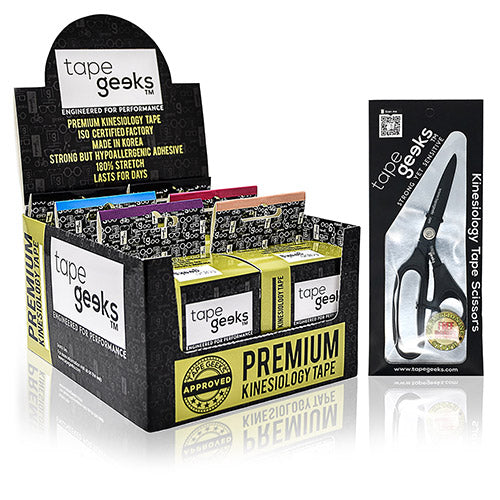
Tapes are widely used by different types of people, regular folks, athletes, chiropractors, therapists, and the list goes on. The question is, what purpose do they serve? Athletes worldwide from high school heroes to international phenoms use tape to help support injured joints, overstretched ligaments, worn muscles, and nearly every body part in-between.

Shop our kinesiology tape now
Shop NowWhat are the different kinds of medical tapes?
Medical tapes come in different sizes and colors. Let’s dive into it without getting too scientific.
- Athletic Tape. Athletic tape is a stiff material that can reduce joint movement. It features a zinc-oxide based glue which is strong and adheres to the skin well. There are different of athletic tapes you can get today, such as the following:
- Under tape. This is a type of athletic tape that is gentler on the skin.
- Elastic tape. If you’re looking for something more flexible, you can apply an elastic tape instead. Typically, it’s made of cotton, which allows the skin to breathe.
- Felt tape. This tape serves as a barrier to the skin, which makes it a more comfortable option compared to the other types of athletic tapes.
- Cohesive bandages. This bandage does not have a glue-adhesive, but it sticks to itself when wrapped around a joint or muscle. This tape is popular in the world of football as it replaces the PVC sock tape. Moreover, it does not lose its stickiness, which means you can use and re-use it several times.

Shop TG Cohesive Bandage
Shop NowKinesiology tape
This type of tape increasingly gains popularity. You have probably spotted a lot of athletes who have colorful tapes stuck to their skin. Kinesiology tape is commonly used in sports because it adjusts to the skin and accommodates movement.
A distinct quality of a kinesiology tape is its stretchiness and flexibility—it’s extremely stretchy! This is because kinesiology tape is designed in a way to mimic the skin’s elasticity to allow wearers to use their full range of motion, which is very unlike an athletic tape.
Additionally, kinesiology tape uses a medical-grade adhesive to ensure it can resist water and it can stay on for a couple of days, even in the shower. At most, kinesiology tape should be worn for three to five days.
At TapeGeeks, we recommend letting your skin breathe after three days of wearing the tape.
The quality of the kinesiology tape matters just as much. Make sure that you avoid rashes and skin irritation with Tape Geeks’ skin-friendly kinesiology tape. Try us out today!
Get the best deals for Tape Geeks' products by visiting our Amazon store today!
Physical therapists believe that the tape can change the information the sensory nervous system sends about pain and body compression. Therapists have used kinesiology tape to lift the skin over tensed and knotted muscles. In fact, a study in 2015 showed that trigger point pain was reduced and flexibility increased for people using kinesiology tape and manual pressure.

Shop our bundles now
Shop NowThe heavy weights
Many athletes and trainers use athletic tapes, though the most popular is the kinesiology tape. Kinesiology tape is not only used by athletes, but people, in general. The tape is highly recommended and used by physiotherapists and chiropractors to aid recovery and support.

What is the difference between athletic and kinesiology tape?
Athletic tape serves as a supportive tape, which is used on athletes to help prevent injury by providing support around an injured joint or muscle. The tape is applied around the wrists, hands, ankles, and feet for a specific athletic activity. Moreover, the tape can retain moisture for extended periods of time, which can cause skin irritation if not removed quickly.

To remove an athletic tape, a pair of blunt-edges scissors, which are also known as shark scissors, are used.
On the other hand, kinesiology tape is used for corrective and supportive purposes. The tape is thin and stretchy. As mentioned, its qualities are similar to the human skin. Additionally, the tape can be used three to five days prior to removal without movement restriction.
Why all the hype about kinesiology tape?
Kinesiology taping was first developed in 1979 by a Japanese chiropractor, Dr. Kenzo Kase. Dr. Kenzo wanted something that could prolong or somehow, continue the effects of manual therapy in between treatment sessions for his patients.

Kinesiology tape has unique properties that enable it to give dynamic support, as it still allows a considerable amount of safe movement. When the tape is applied to the skin, it lifts the skin and soft tissue away from the muscle to allow increased blood flow and lymphatic drainage, which many say that this could potentially lead to pain relief. Note that pain relief cannot be guaranteed.
Does it work?
A review in the British Journal of Sports Medicine showed that “Kinesiology taping is superior to minimal intervention for pain relief.” Other studies have found that taping may potentially increase range of motion slightly, but there’s no evidence that one type of tape is better than another.

A randomized, double blind, controlled trial, recruited 187 patients with grade I-III KO. The individuals were separated, with some to use Kinesiology taping and the others in a control group. Kinesiology tape and non-specific tape was applied on the affected knee area for four weeks—pain was evaluated at a baseline, after a month of taping, and after another month without taping.
Majority of the individuals said that the tape reduced their knee pain, along with the use of painkillers, which significantly decreased.
Is kinesiology taping just a hype?
Study after study has documented the benefits of the placebo effect. People who think they’ve been given caffeine or morphine feel less fatigue or pain, even if all they’ve ingested is a sugar pill.
Indeed, taping can be regarded as having a placebo effect, in turn, taping will provide the wearer relief from pain. Placebos have been shown to be most effective for pain management, stress-related insomnia, and cancer treatment side effects.

A placebo is anything that seems to be a real medical treatment, but in reality, it is not. Placebo can come in the form of a pill, shot, or a fake treatment. Additionally, placebo contains an active substance that is meant to affect one’s health.
Placebos are used during studies to help researchers understand the effect of a new drug or some other treatment. For example, some people will be given a new drug to help lower cholesterol, while others would be given a placebo.

Shop our kinesiology tape now
Shop NowThe placebo effect is said to be due to a person’s expectations. If a person expects a drug to do something, then it’s likely that the body’s own chemistry can cause effects similar to what a medication might have caused. Experts also believe that there’s a link between how strongly a person expects to have results and whether or not results occur. The stronger the feeling, the more likely it is that a person will experience positive effects.

Some experts suggest that there may be a placebo effect in using kinesiology tape, due to the high number of athletes who believe that it is helpful. In fact, a group of researchers dug deeper into the placebo effect of kinesiology tape. The study supports a placebo mechanism of action for the tape’s facilitatory technique. However, its effect is trivial.
Conclusion
There are plenty of medical or sport tape options out there, and what you use tends to be a matter of personal preference. Kinesiology tape is a popular choice because it offers great flexibility as it supports movement, unlike other athletic tapes today. Additionally, kinesiology tapes come in many cool colors! Be sensible when using tape—it’s not a cure for everything. Instead, just think of taping as part of your overall routine, and make sure you pick a tape that is right for the job.

It does make sense why kinesiology tapes are commonly used by athletes, since competitions are won or lost by fractions of a second, and even a .05% performance gain could be the difference between standing on the podium or sitting off to the side.

Shop our accessories and more
Shop NowSubscribe to the TapeGeeks Newsletter for new videos, discounts and more!Join The Geeks Club









